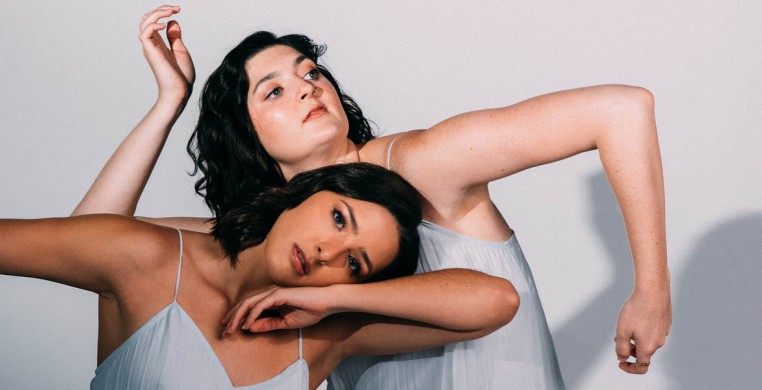Last weekend, Alluvion Dance Chicago (ADC) presented two works by artistic director Johnny Huntoon-Starcher and associate artistic director Morgan Cutler in a program titled “Over Under” in the intimate Edge Theater on Chicago’s far north side. The program was short and to the point. Each piece lasted approximately 15-20 minutes, coupled with a 15-minute intermission and, after a late start, had me in and out in a little over an hour. The digital program left much to the imagination, providing nothing more than two gorgeous images by an uncredited photographer and the names of the choreographers, dancers, lighting designer (Claire Doty), and the company’s Board of Directors.
The split bill begins with Cutler’s “Over,” an allegory about how the social web that we weave around ourselves serves as a safety net in times of turmoil. A string of soloists, dressed in beige and blue tank tops and long-sleeved shirts over black and brown pants, sporadically jump in and out of the wings. Angular top-down lighting shifts from left to right, accompanied by a repeating violin riff played over the sound of crashing waves. The dancers move en masse, their rigid torsos rotating in wider and wider circles as they coagulate into a mass in the center. They grip and grab and hold each other close, but one gets loose, and a representative is sent out to guide the lost one back into the fold. After wrangling the outlier to a standstill, the savior takes the other’s hand in hers and traces circular tracks in the air. The two evolve into mirror images of each other, the radical being gently coerced back into the group. The recurring theme of a lost one being reeled back in by a savior repeats several times, making up the crux of the piece. A solution for this dilemma is discovered in the final moments of the piece, as the full company forms a strong chain, each “link” connected by one person latching onto the other in succession, bobbing and drifting together like a long patch of seaweed loosened and floating atop the ocean, the sound of waves crashing distantly against the shore.
Huntoon-Starcher’s “Under,” featuring the same company of dancers, minus one, contains no noticeable grand narratives, delivering instead a series of abstract movements. The work begins with 6 dancers in long-sleeved blue shirts and black leggings bent forward at the waist, their arms hanging limp. The violin-heavy, meter-less music activates the dancers, rolling their shoulders, swinging their arms, slicing the air with their hands, growing in intensity as the dynamic of the music swells to a cacophony—and the music did get loud!
This piece contains several parallels to the previous work—a clenched chain of hunched, drifting bodies, necks swirling as dancers transition to a new formation, a brief duet of one dancer tracing circles through the air with her partner—but there are unique moments. A trio in a triangular formation performs a series of forced rond de jambes, the usual gracefulness of the circular leg motion being made stiff and strained creating swishing noises with their feet. “Under” felt like watching an amoeba under a microscope, constantly shifting form, stretching and contorting this way and that, but always snapping back into a unified, amorphous shape.
Both pieces felt too similar, in movement style, choreographic choices, costume and music selection, and had more in common than any individual distinctions. Also, the music was so loud at points that I had to plug my ears. A little more information on each piece would have been helpful in determining the intention of the choreographers.
With no additional information, I imagine a hint of motive in the company’s name. “Alluvion” refers to the process by which flowing water changes a landmass by depositing new materials upon it. That takes time and is not always visible right away, only after long periods of erosion. Perhaps “Over Under” is doing just that, making figurative waves and depositing new ideas that will one day form exciting frontiers to be explored. In the present, however, the two pieces in “Over Under” were too similar and repetitive, despite the show’s short length.


